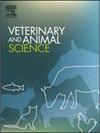A Case Series on Streptococcus agalactiae Infection in Llamas and Alpacas in a Semi-Intensive Breeding System in Southern Brazil
IF 1.9
Q2 AGRICULTURE, DAIRY & ANIMAL SCIENCE
引用次数: 0
Abstract
The South American Camelids (CSA), including llamas (Lama glama) and alpacas (Vicugna pacos), are primarily concentrated in the Andean countries of Argentina, Bolivia, Chile, and Peru, where they represent an important source of income for the local population. In Brazil, their captive breeding, although recent, has gained significant attention. These animals can act as potential carriers and transmitters of diseases, especially those with zoonotic potential. For many years, Streptococcus agalactiae was considered a strictly contagious bacterium among bovine herds. However, it has now been identified in various other animal species. This study aims to describe the clinical aspects of an outbreak of S. agalactiae in a herd of llamas and alpacas in southern Brazil. Two llamas and one alpaca presented chronic formation of encapsulated suppurative abscesses on the flank region. After conducting microbiological cultures, the pathogen was confirmed using MALDI-TOF MS. An antibiogram was performed, demonstrating antimicrobial sensitivity to most evaluated agents but indicating resistance to tetracycline, oxacillin, and orbifloxacin. The animals fully recovered after treatment with penicillin, with no recurrence of the infection. This study describes the first cases of S. agalactiae infection in llamas and alpacas in Brazil, highlighting the importance of further research on the health, breeding, and management of these animals.
巴西南部半集约化养殖系统中大羊驼和羊驼无乳链球菌感染病例系列
南美骆驼科动物(CSA),包括美洲驼(Lama glama)和羊驼(Vicugna pacos),主要集中在阿根廷、玻利维亚、智利和秘鲁的安第斯山脉国家,它们是当地居民的重要收入来源。在巴西,它们的圈养繁殖虽然是最近才开始的,但已经引起了极大的关注。这些动物可能是疾病的潜在携带者和传播者,特别是那些具有人畜共患病潜力的动物。多年来,无乳链球菌被认为是牛群中具有高度传染性的细菌。然而,现在已经在许多其他动物物种中发现了它。本研究旨在描述巴西南部一群大羊驼和羊驼中无乳链球菌爆发的临床方面。2只大羊驼和1只羊驼的侧腹呈慢性包膜化脓性脓肿。在进行微生物培养后,使用MALDI-TOF ms确认病原体,并进行抗生素谱检查,显示对大多数评估药物的抗菌敏感性,但显示对四环素,oxacillin和奥比沙星耐药。经青霉素治疗后,动物完全康复,无感染复发。本研究描述了巴西大羊驼和羊驼中首例无乳链球菌感染病例,强调了对这些动物的健康、繁殖和管理进行进一步研究的重要性。
本文章由计算机程序翻译,如有差异,请以英文原文为准。
求助全文
约1分钟内获得全文
求助全文
来源期刊

Veterinary and Animal Science
Veterinary-Veterinary (all)
CiteScore
3.50
自引率
0.00%
发文量
43
审稿时长
47 days
 求助内容:
求助内容: 应助结果提醒方式:
应助结果提醒方式:


